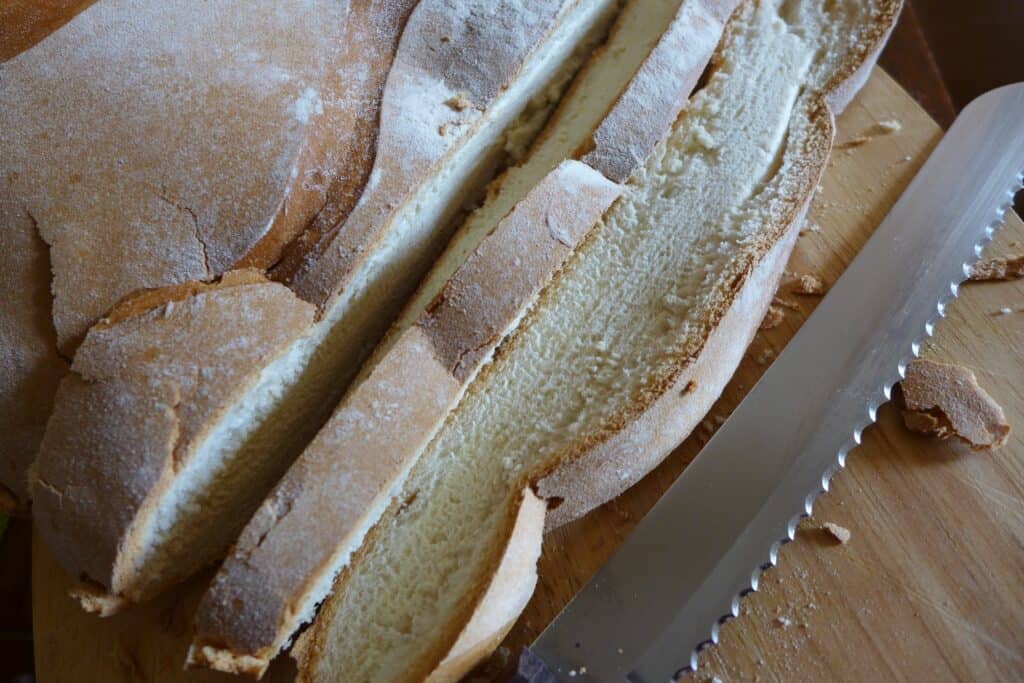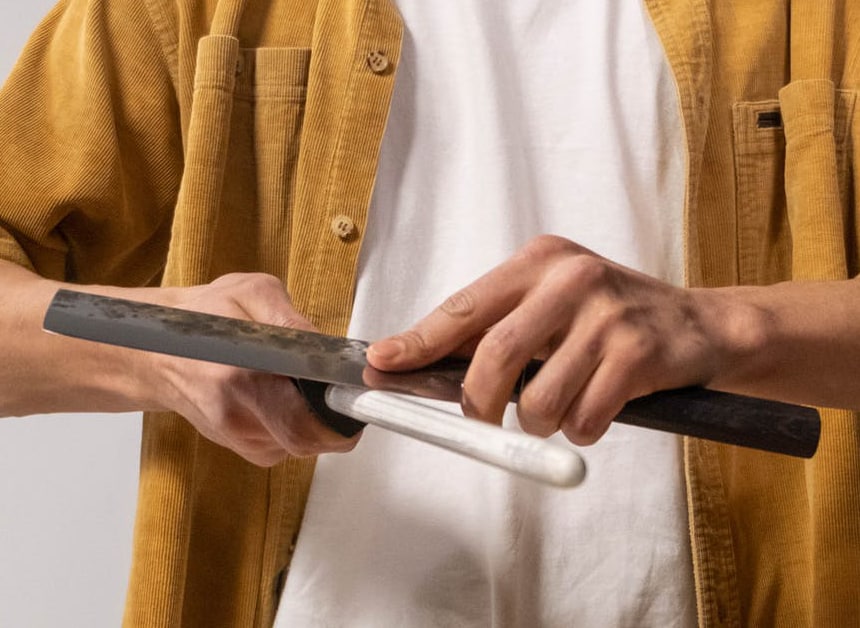
When it comes to sharpening our knives, there is one in particular that often gets forgotten, the serrated knife.
It’s no immediately obvious that serrated knives can be sharpened, but they can.
In fact, serrated knives can be sharpened to a razor-sharp edge, and you don’t even need any super-specialized tools.
In this article we’ll explore the tools you’ll need to sharpen your serrated knives, and offer a step-by-step guide of how you can sharpen your serrated knives yourself at home.
You can sharpen a serrated bread knife using a ceramic sharpening rod. You can also use a piece of cardboard to help remove the burr from the knife after sharpening.
For a full guide read my detailed description below.
Tools you will need to sharpen serrated knives
There are all sorts of guides out there with all sorts of complicated methods of sharpening a serrated knife. I’m going to keep it simple.
What you need to sharpen a serrated knife:
- Ceramic sharpening rod (check out my recommendation on Amazon here)
- Cardboard (not essential)
When you sharpen anything, what you are really doing is removing a thin layer of material to expose a fresh sharp edge.
Think about sharpening a pencil, the wood and core are completely removed to show the fresh new point.
The same is true of knife sharpening, you will be removing small particles of the blade to unveil a new layer. Therefore you need to use a material harder than the blade steel itself.
That’s why it’s important that you use a ceramic rod. If you don’t have one I’d highly recommend it. They aren’t that expensive and you can use them to sharpen any knife, not just serrated ones.
Tools to avoid
I much prefer to use ceramic sharpening rods, especially for a relatively delicate task like sharpening a serrated blade.
Tools not suitable for sharpening serrated knives:
- Diamond encrusted sharpening rods
Diamond sharpening rods have a diamond-encrusted surface, providing an extremely hard surface to sharpen against.
Although a diamond rod is perfectly capable of sharpening a serrated knife, I would not recommend using a diamond rod for this job.
Diamond rods can be very effective for sharpening normal flat stainless steel knives since diamond is such a hard material they are extremely abrasive.
However; because sharpening serrated knives is a slightly more delicate process than sharpening a normal knife and there’s more opportunity for error.
It’s much more difficult to get an even result with a diamond sharpening rod because it is so abrasive.
If you stick with the more delicate ceramic sharpening rod then the process is really easy, even for someone completely new to knife sharpening.
How to sharpen a serrated bread knife
Sharpening a serrated knife is a little different than sharpening a normal flat knife as you need to sharpen each side differently.
A serrated knife has two different edges to the blade:
- Flat edge – When the metal continues flat right to the end of the blade
- Beveled edge – Where there is a small beveled (curved) edge just before the end of the blade
Both of these sides need to be treated differently.
You will want to start by sharpening the flat side of the blade. For that, you’ll need the ceramic sharpening rod.
Hold the ceramic rod pointing down onto a flat surface, such as a table. Holding the rod vertical against a table like this will help to keep it straight and stable.
You can just hold the rod freehand but it will be more difficult to keep the same angle whilst sharpening.
Place the flat side of the knife blade nearest to the hilt of the knife at a 20-degree angle to the ceramic rod.
Only applying to a little bit of pressure between the blade and the rod pull the knife down and towards you so that the whole flat edge of the blade sharpens along the ceramic rod.
You should hear a nice and gentle ‘thu thu thu thu thu’ sound as the teeth move along the rod.
Repeat this until a burr is formed on the beveled edge of the knife.
A burr is where the blade of the knife starts to fold over to form a little ridge or hook-like edge to the opposite side of the blade to the side you’re sharpening.
Next, we need to remove the burr. There are two options we can use to do this, one is by using our ceramic rod still and one is by using a piece of cardboard with some polish on it.
There’s a brilliant video below which describes how to sharpen serrated knives using a ceramic rod and the cardboard method which is well worth watching.
1. Remove the burr using the ceramic rod
This technique will remove the burr from one groove at a time.
Start with the groove nearest the hilt of the knife and find the point on your ceramic rod which matches the width of the groove.
Place the rod in the groove at a 20-degree angle and gently pull down to remove the burr.
You only need to do this enough to remove the burr so just one stroke will do it. You should be able to feel whether the burr has gone by running your finger or nail along it.
Repeat this process for each groove along the knife. Try to be consistent with the length of the stroke and pressure as you want a nice even result along the whole blade.
2. Remove the burr using cardboard
This is a really great tip which you might not find people doing very often,
It’s especially useful if you’re sharpening a number of serrated knives in one go or your sharpening quite small serrated knives (like steak knives) which might have grooves too small for your ceramic rod.
Step 1. Add some polish to a piece of corrugated cardboard. The polish will help to remove the burr from your blade.
Step 2. Create a crease through the middle of the cardboard to make a little ridge. This will get flattened out as you sharpen so don’t worry about that too much, it will still help.
Step 4. Lay the cardboard flat down on a tabletop and place the beveled side of the blade at a 20 degree angle to it. You might need to hold the cardboard in place with one hand.
Step 5. Push the blade from tip to hilt along the cardboard, you should only need to do this a few times and the burr should be removed. Otherwise don’t worry, just keep going until the burr is removed.
This is a really nice way to remove the burr as it is so gentle and helps to keep the edge even throughout, there is far less chance of doing an uneven job than if you try to remove the burr on each groove separately.
Here’s a great video on using the cardboard technique. It’s a little long, so I’ve sped it up as you can still understand what’s going on:
How often should you sharpen a serrated knife
As we’ve discussed, sharpening a serrated knife can take a little more effort than sharpening a normal knife, but after you’ve tried it you’ll realize that it really doesn’t take that long, and it really isn’t very difficult.
The great thing is that most serrated knives don’t need to be sharpened that much. This is due to three reasons.
- They aren’t used nearly as frequently as many of your other knives
- A Lot of what they are used to cut is quite soft
- They still perform really well even when they become a little blunt
Whilst I would advise sharpening a normal knife every 6 to 12 months, a serrated knife, and especially a bread knife, probably only needs to be sharpened every 12 – 24 months.
If you do that you’ll always have a pretty sharp knife to work with. So the ten minutes it might take to keep that edge sharp is really worth it in the long run.
Can you hone a serrated knife?
Yes, you can hone a serrated knife. But you’ll need a different tool than the ceramic sharpener I recommended above.
Honing is the act of re-aligning the blade of a knife. Imagine a knife blade as thousands of microscopic teeth in a straight row. When the knife is used these little teeth bend over and go out of alignment.
Honing a knife realigns these teeth, it does not remove any material as a sharpener would.
Because of this key difference, you’ll find honing steels are made from stainless steel, as this makes them generally the same hardness as stainless steel knives.
Honing a serrated knife follows the same process as the Method 1. Sharpening method which I explained above.
The thing is though, it honestly probably isn’t worth honing your serrated knives. I recommend honing a normal knife at least every three cooking sessions. But honing a normal knife is so quick and easy that it isn’t really any inconvenience.
Serrated knives are still very effective even if the microscopic teeth of the blade aren’t in perfect alignment, so I wouldn’t really bother with honing too much as long as you are sharpening your serrated knives every year or two.

